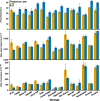Genetic Variability in Phosphorus Responses of Rice Root Phenotypes
- PMID: 27294384
- PMCID: PMC4905936
- DOI: 10.1186/s12284-016-0102-9
Genetic Variability in Phosphorus Responses of Rice Root Phenotypes
Abstract
Background: Low phosphorus availability is a major factor limiting rice productivity. Since root traits determine phosphorus acquisition efficiency, they are logical selection targets for breeding rice with higher productivity in low phosphorus soils. Before using these traits for breeding, it is necessary to identify genetic variation and to assess the plasticity of each trait in response to the environment. In this study, we measured phenotypic variation and effect of phosphorus deficiency on root architectural, morphological and anatomical traits in 15 rice (Oryza sativa) genotypes. Rice plants were grown with diffusion-limited phosphorus using solid-phase buffered phosphorus to mimic realistic phosphorus availability conditions.
Results: Shoot dry weight, tiller number, plant height, number of nodal roots and shoot phosphorus content were reduced under low phosphorus availability. Phosphorus deficiency significantly reduced large lateral root density and small and large lateral root length in all genotypes, though the degree of plasticity and relative allocation of root length between the two root classes varied among genotypes. Root hair length and density increased in all genotypes in response to low phosphorus. Nodal root cross-sectional area was significantly less under low phosphorus availability, and reduced cortical area was disproportionately responsible for this decline. Phosphorus deficiency caused a 20 % increase in the percent cortical area converted to aerenchyma. Total stele area and meta-xylem vessel area responses to low phosphorus differed significantly among genotypes. Phosphorus treatment did not significantly affect theoretical water conductance overall, but increased or reduced it in a few genotypes. All genotypes had restricted water conductance at the base of the nodal root compared to other positions along the root axis.
Conclusions: There was substantial genetic variation for all root traits investigated. Low phosphorus availability significantly affected most traits, often to an extent that varied with the genotype. With the exception of stele and meta-xylem vessel area, root responses to low phosphorus were in the same direction for all genotypes tested. Therefore, phenotypic evaluations conducted with adequate fertility should be useful for genetic mapping studies and identifying potential sources of trait variation, but these should be confirmed in low-phosphorus environments.
Keywords: Aerenchyma; Lateral roots; Oryza sativa; Phosphorus; Root anatomy; Root hairs; Stele; Xylem.
Figures







Similar articles
-
Anatomical root responses of rice to combined phosphorus and water stress - relations to tolerance and breeding opportunities.Funct Plant Biol. 2019 Oct;46(11):1009-1022. doi: 10.1071/FP19002. Funct Plant Biol. 2019. PMID: 31543094
-
Many paths to one goal: Identifying integrated rice root phenotypes for diverse drought environments.Front Plant Sci. 2022 Aug 22;13:959629. doi: 10.3389/fpls.2022.959629. eCollection 2022. Front Plant Sci. 2022. PMID: 36072326 Free PMC article.
-
Genetic variation in morphological traits in cotton and their roles in increasing phosphorus-use-efficiency in response to low phosphorus availability.Front Plant Sci. 2022 Nov 30;13:1051080. doi: 10.3389/fpls.2022.1051080. eCollection 2022. Front Plant Sci. 2022. PMID: 36531355 Free PMC article.
-
Enhancing phosphorus and zinc acquisition efficiency in rice: a critical review of root traits and their potential utility in rice breeding.Ann Bot. 2013 Jul;112(2):331-45. doi: 10.1093/aob/mcs217. Epub 2012 Oct 15. Ann Bot. 2013. PMID: 23071218 Free PMC article. Review.
-
Root traits contributing to plant productivity under drought.Front Plant Sci. 2013 Nov 5;4:442. doi: 10.3389/fpls.2013.00442. Front Plant Sci. 2013. PMID: 24204374 Free PMC article. Review.
Cited by
-
Genotype-specific relationships among phosphorus use, growth and abundance in Daphnia pulicaria.R Soc Open Sci. 2017 Dec 13;4(12):170770. doi: 10.1098/rsos.170770. eCollection 2017 Dec. R Soc Open Sci. 2017. PMID: 29308224 Free PMC article.
-
IR64: a high-quality and high-yielding mega variety.Rice (N Y). 2018 Apr 9;11(1):18. doi: 10.1186/s12284-018-0208-3. Rice (N Y). 2018. PMID: 29629479 Free PMC article. Review.
-
Genome wide association analysis of root hair traits in rice reveals novel genomic regions controlling epidermal cell differentiation.BMC Plant Biol. 2023 Jan 4;23(1):6. doi: 10.1186/s12870-022-04026-5. BMC Plant Biol. 2023. PMID: 36597029 Free PMC article.
-
Tolerance of Iron-Deficient and -Toxic Soil Conditions in Rice.Plants (Basel). 2019 Jan 28;8(2):31. doi: 10.3390/plants8020031. Plants (Basel). 2019. PMID: 30696039 Free PMC article. Review.
-
Association mapping for root system architecture under varying levels of phosphorus application in Brassica juncea L. Czern & Coss.BMC Genomics. 2025 Aug 11;26(1):740. doi: 10.1186/s12864-025-11840-2. BMC Genomics. 2025. PMID: 40790467 Free PMC article.
References
-
- Borch K, Bouma TJ, Lynch JP, Brown KM. Ethylene: a regulator of root architectural responses to soil phosphorus availability. Plant Cell Environ. 1999;22:425–431. doi: 10.1046/j.1365-3040.1999.00405.x. - DOI
LinkOut - more resources
Full Text Sources
Other Literature Sources

